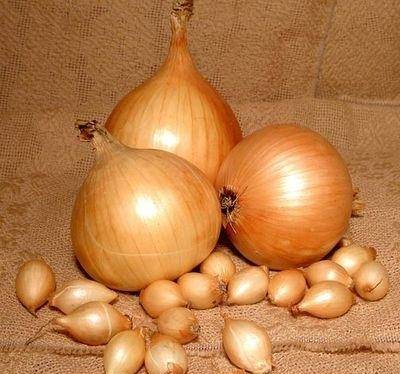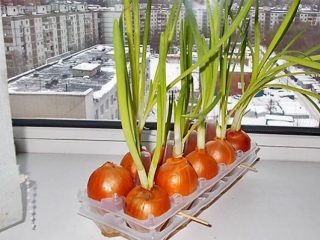Content
Any owner of a personal plot will take care of growing onions, because even if the plot is small, it is nice to always have fresh onion greens on hand. Yes, and it is not always possible to get some attractive varieties of onions on the market in the form of sets, but they can be grown from seeds, the variety of which fills the shelves of any garden store in the autumn-spring period.
In recent years, the method has become especially popular growing onion sets planted before winter. Previously, for some reason, it was believed that this was possible only in the southern regions of Russia with mild winters. But it turned out that this is not at all the case - throughout almost the entire territory of Russia, except for the most northern and eastern regions, planting onion sets before winter makes it possible to get a good harvest, and even 3-5 weeks earlier than usual. But to obtain a guaranteed result, it is quite important to choose the appropriate variety of onion sets for planting before winter for a particular region.
Onions: criteria for choosing a variety
It is possible that for beginning gardeners, onion varieties may differ only in color and pungency of taste.In fact, there are quite a lot of criteria by which one can distinguish and choose one or another type of onion. Therefore, before thinking about which variety is best for winter sowing, you need to familiarize yourself with them.
Ripening period
According to ripening time, onions are usually divided into:
- early ripening (or early ripening) varieties - the growing season usually does not exceed 90 days;
- mid-season - the time from the appearance of leaves to the full ripening of the bulbs is about 100-110 days;
- late - the bulbs ripen no less than 120 days from the start of the growing season.
This can be beneficial if you are growing onions for sale.
Nature of branching
On this basis, all onion varieties are divided into small-cavity, medium-cavity and multi-cavity. In the first group, during the growing season, only one bulb, or maximum two, is formed from the sets. In varieties of the second group, from two to four bulbs can form. Finally, multi-nest varieties of onions often form five or more bulbs in one nest. A typical representative of such onions is the Pechora variety.
This criterion does not particularly affect the choice of variety for winter planting. The most common varieties are small-nest onions, but no one will stop you from planting other varieties.
Bulb size
The size of the bulbs grown often makes a difference, especially for those growing onions for sale.There are varieties for which it is useless to apply various agrotechnical techniques - in any case, they will not grow large. Most often, the weight of one onion does not exceed 50 grams. Typically, these are multi-nest varieties of onions.
The weight of a ripe bulb of medium-sized varieties ranges from 50 to 120 grams. And large-sized onion varieties weigh more than 120-130 grams.
The size of the onion also does not affect its planting; rather, it is a matter of habit and taste of the person who is going to grow the onion.
Long and short day varieties
But this criterion is one of the most important when choosing a suitable variety of winter onion sets. Varieties that require long daylight hours for good growth are unlikely to be suitable for your purposes, since they will already be in full growth, while daylight hours will still be quite short.
But for winter sowing, varieties with medium and short daylight hours are ideal. Already from the beginning to mid-April they will begin to develop intensively and by June they will be able to practically ripen.
Taste and color of bulbs
This criterion does not at all affect the choice of variety for planting before winter, but it is very important for the gardener himself, since it is these characteristics that often determine a person’s attachment to a particular variety of onion.
Onions can be spicy, semi-sharp and sweet to taste. But as for color, they usually distinguish:
- Onions with yellow scales;
- White onion varieties;
- Raspberry or red onion;
- Onion with brown scales.
It is also worth mentioning that there are varieties of onions that can only be grown from seeds or even using seedlings. Such, for example, is the famous Exhibition bow. Of course, this onion is completely unsuitable for winter planting, since it is a heat-loving plant.
The best winter varieties
Despite the fact that Dutch onion varieties are considered the best for planting before winter, some of the best Russian varieties will also be mentioned in the following review. As a rule, in winter hardiness they are in no way inferior to their Dutch comrades and have been grown in various regions of Russia for several centuries, and this is quite enough for them to be the most reliable candidates for planting for the winter.
Arzamas
The ancient Russian variety is classified as mid-breeding and mid-ripening. The taste is spicy. Scales dark yellow with brown tint. It stores well and can withstand frost, but is not resistant to downy mildew and the onion fly loves it.
Bamberger
A variety of German selection, mid-late. The bulbs themselves are small, elongated, have yellow scales and a semi-sharp taste.
Danilovsky
The old Russian onion variety is classified as mid-season and small-growing. It has good yield and good keeping quality. The color is red-violet, the shape of the bulb is rather flat. In size it can be classified as medium, growing up to 150-160 grams. The taste is semi-sharp, with sweet undertones.
Radar
One of the most popular Dutch varieties for planting before winter, mid-season. The radar bow is resistant to any weather conditions, so it practically does not shoot. The bulbs are large in size, flat-round in shape with yellow scales. Has a semi-sharp taste.
Red Baron
Onions are characterized by early ripeness, ripening in 90 days.The bulbs are very beautiful, red-violet in color, almost round. The taste is semi-sharp, closer to sweet, the size is quite large, reaching 200 grams.
Senshui
An early-ripening variety of Japanese selection, resistant to bolting and downy mildew. It has good yield indicators. The bulbs are semicircular in shape with dark golden scales, almost sweet in taste and very aromatic. But like most sweet onions, it doesn’t last long.
Strigunovsky
Also refers to ancient Russian varieties of small-growing type. Cold-resistant and stores well. Early ripening and has good yield indicators. The taste is pungent and not always resistant to some diseases.
Sturon
Dutch breeders, taking the famous Stuttgarter Riesen as a basis, developed this improved specimen. It is resistant to both bolting and various diseases. Good yield and shelf life. The taste is rather pungent, the bulbs are ellipsoidal with dark yellow scales, reaching large sizes, up to 190-200 grams.
Timiryazevsky
One of the old Russian varieties, most suitable for cultivation in the northern regions of Russia. Small-growing, early-ripening, has good yield indicators. Excellent keeping quality, can be stored until spring. The bulbs are small in size and have a pungent taste. The scales are yellowish-grayish.
Troy
A very early variety of Dutch selection, ripens in 65-75 days. It is interesting in that it can be planted both in autumn, before winter, and in early spring. Tolerates different weather conditions and is resistant to shooting.The yield is good, the bulbs are large, flat-round in shape with a semi-sharp taste and golden-brown scales. Their shape can be very diverse.
Centurion
Hybrid variety with mid-early ripening. He is not in danger of being shot. It is distinguished by high yield, bulbs with a pungent taste, semicircular shape, and medium size. It is not stored for long, up to three months. The outer scales are golden brown, tightly fitting.
Shakespeare
It is considered the best onion among the latest Dutch varieties for winter planting. It is very cold-resistant and is not afraid of diseases and pests; it is also resistant to bolting. The bulbs are large in size and slightly flattened in shape and have a semi-sharp taste. Early ripening onions - the growing season can last only 2.5 months.
Stuttgarter Riesen
Another variety that can be planted at any time of the year. It is equally suitable for both autumn and spring planting. Since it has an average ripening period and unpretentiousness, it will have time to ripen in almost any conditions. The bulbs are quite large in size, flattened in shape with golden-brown scales. The taste is semi-sharp. The bulbs also store quite well.
Ellan
The sweetest onion variety of those intended for winter planting. It is distinguished by its early ripening and cold resistance. This is a typical representative of short-day varieties, and can ripen by the beginning of June, when other onions are still far from ripening. It has good yield; the bulbs are round, with straw-colored scales.
Rules for choosing bulbs and planting
Let's say you have chosen the best varieties for planting before winter. But that is not all. To ensure that your efforts are not wasted, you must follow the following rules when selecting onion sets for planting.
- If you have even the slightest doubt about the resistance to bolting of the selected variety, plant only the tiniest bulbs, no more than 1 cm in diameter. Moreover, if you somehow got bulbs of such a small size, then plant them for the winter, do not even thinking about their varietal affiliation. You still won’t be able to save them until spring, but you will get at least some kind of harvest.
- The seedlings - your planting material - should not smell of rot, mold or dampness and should rustle pleasantly.
- The seeds should not contain traces of infections, stains, scratches or other mechanical damage.
- Immediately arrange the seedlings by size and plant only planting material of the same fraction in one place in order to avoid problems with uneven germination in the spring.
- All onions should be firm and dense.
Winter onions are planted to a depth of about 10 cm, there should also be about 10 cm between the bulbs, and row spacing can be increased to 10-15 cm. Planting dates are determined depending on the weather conditions in the region, but 20-30 years should still pass before the onset of stable frosts days after disembarkation.
It is advisable to mulch winter ridges with straw or spruce branches or other organic material.
Planting onions before winter is not at all as difficult as it seems and allows you to save time and effort in the spring, when any gardener really needs them.




























